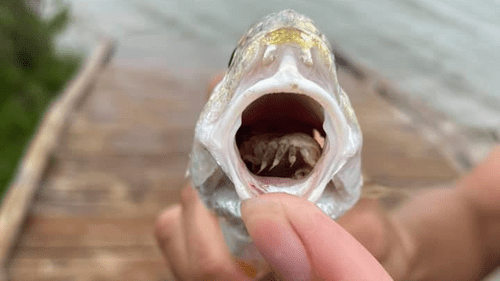Texas Parks and Wildlife are apparently trying to make sure you don't sleep until Halloween, or possibly ever, with a “pretty spooky” photo they posted to Facebook. It's of a fish – technically an Atlantic Croaker – whose tongue has been consumed, and entirely replaced, by a parasitic isopod (Cymothoa exigua).
We've covered the so-called tongue-eating louse before, but just in case you've finally managed to get its existence out of your memory, it's baaaack. In fact, the tongue-eating louse never went away, it's just those of us that don't live near the coastline of Mexico or the Southern United States are privileged to forget it. The photograph was posted by the Galverston Island State Park to their Facebook page, attracting reminiscence from Texans who sail and horror from everyone else.
The louse's popular name is no lie (other than not being a louse). It's life-cycle depends on the females cutting the blood supply to the tongue and only the tongue, of fish they parasite upon. The tongue necrotizes and the female louse locks onto the stub to replace it. They mate with the males, who take up positions in the gills, and release eggs that go off to seek new fish to terrorize.
Like all the best parasites, the lice don't kill their host, allowing them to feed on their blood and mucus all the longer, instead assisting in swallowing like a real tongue, arguably replacing parasitism with a sort of forced symbiosis. Related species, which attack fishes mouthparts but don't replace organs, shorten lifespans and affect reproduction. It's likely C. exigua does too, and Dr Kory Evans of Rice University told The Houston Chronicle the presence of multiple females in one mouth would probably spell a quick doom for the host. They're also suspected of transmitting diseases.

It's all really just evidence that if the world had been made by “Intelligent Design” then the designer was auditioning for a gig writing horror movies.
The appropriately named Mark Fisher, Science Director at the Texas Parks and Wildlife Department, told local radio station KSAT; “Tongue-eating louse or ‘snapper-choking isopod’ are somewhat common among certain species of fish, like Atlantic croaker, spotted seatrout, and a few species of snapper.”
“It can be a surprise to peer into a fish’s mouth and have another set of eyes looking back at you,” Fisher added.
So far there is no record of the “louse” treating human tongues the same way, but there are accounts of them delivering painful bites to people who tried to examine them.
In small compensation for what this has done to your brain, those newly discovering this unique case of a parasite replacing an organ now have a set of comebacks if anyone asks you if “the cat got your tongue”.
[H/T Phys.org]




